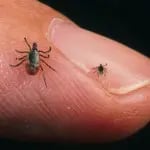Top 5 Pests in the Fall and Winter Months

The first day of fall landed on September 22, 2013 this year. That means we are a smidgen over one month of “fall weather.” Yet, up until this week in the mid-Atlantic area, we were experiencing record temperatures reaching into the high 70’s and even low 80’s in some locations. We saw this beautiful weather play a positive part in lawn care fertilizing, extending summer beach trips and much more!
Now that temperatures have dropped and we’re seeing 40’s – 50’s across the board this week, it’s time to finally release this year’s top five fall and winter pests in the mid-Atlantic states! Now that the seasons have changed, we are seeing a number of pests lurking around and new pests emerging. With summer in the rear view, insects and bugs like stinging insects, fleas and ticks linger around the home seeking warmth and shelter. Meanwhile, a notorious new set of seasonal fall pests are ready to make their rounds.
1. Rodents
Whether you own a home or rent an apartment or condo, rodent control and exclusion should be your number one fall pest control priority. Rodents – particularly mice and rats – are one of the most problematic pests – especially in the fall! Did you know, when mice creep around your home they are leaving tracks of urine with them! All-in-all, rodents are fall pests you do not want to deal with. If there is something you would want to get taken care of professional it should be these infamous pests! These critters are going to seek warmer areas inside the home such as in your walls, closets, pantries and attics. What can you do? Conduct a thorough exterior inspection of your home, seeking any gaps and holes where rodents may enter. Be on the lookout for bite marks and droppings, which can indicate a rodent infestation. If you want immediate assistance professionally, Green Pest Solutions offers $50 off Rodent control.
2. Flies
Flies can be a year-round pest issue if you are not careful and clean. Fly populations tend to increase in the fall because they’ve had all year to increase. As a result, when temperatures drop, they tend to seek warmer areas and retreat inside your home. Flies may be overwintering inside your home without you even knowing. However, as soon as the first warm day of fall comes around, they will show and come out of hiding. If there is one think you take away from this is some fly species have the potential to land lethal diseases such as tuberculosis, typhoid, dysentery and diarrhea. Species to watch out for are: cluster flies, fruit flies and house flies.
3. Stinging Insects
After a busy summer, these insects can be quite active. Yellow jackets and honey bees for example have been working all summer long to create the largest nest possible. At this time in the seasons, it can become a struggle to feed so many mouths while temperatures drop and food sources are scarce. Under these circumstances stinging insects can become highly hostile as they seek a food source. What can you do? If you think you’ve found a nest of any kind, call a Green Pest Solutions representative. We will help you identify the source and determine if it needs removed. Species to look out for are: yellow jackets and honey bees.
4. Ants
You can be sure that cool autumn mid-Atlantic weather will bring ant trails indoors. Ants sometimes move their colonies into the walls of the home or beneath a slab of foundation to escape the chill. Effective ant control is about locating the nest and preventing ants from getting inside. A Green Pest Professional can help devise an integrated pest management ant control solution that is faster, more effective, and less reliant on pest control materials than a DIY approach may be. Species to watch for: carpenter ants, pavement ants, odorous house ants. Call today for $50 off ant solutions.
5. Fleas and Ticks
Fleas and Ticks prefer temperatures and humidity ranges that the mid-Atlantic provides only parts of the year. Although flea numbers may be highest during the spring and summer, fleas are abundant and active all year long and are fully capable of tormenting flea-allergic patients and transmitting tapeworms and serious veterinary and human bacterial diseases. They survive all year long and their populations have increased year-over-year. In fact, according to the Centers for Disease Control (CDC) the number of Lyme disease cases diagnosed in the US every year is around 300,000, according to new figures released by the CDC. This number is about 10 times higher than the number official reported.
Occasional Invaders this time of year can include a bevy of unique fall insects, commonly referred to as occasional invaders. This includes stink bugs, box elders and ladybugs. These pests enter homes in search of overwintering sites where they can wait out the winter. While these insects typically do not cause structural damage, they are generally considered a nuisance. Species to watch for: stink bugs, lady bugs, box elders.
What can you do to help reduce fall pests?
- Seal gaps around windows and doors, including garage doors.
- Be sure screens on windows are in good repair and do not have any openings.
- Seal gaps around the area where pipes and electrical/cable lines enter the home.
- Look for openings around soffits, eaves, attic fans, windows and vents in the attic used for ventilation. Many times these areas are not screened, allowing overwintering pests inside.
- Inspect chimneys. Be sure the damper is closed when not in use. If your home has a wood-burning fireplace, lighting a fire may discourage the insects from using the chimney as an entry point.